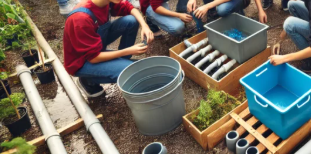Eco-Engineering – Sistema di raccolta delle acque piovane
Institution
Liceo Scientifico
Institution Typology
School
Country
Italy
Stakeholders involved
Students: Active participants in the design and implementation of the system
Teachers: Coordinators and facilitators of the activities
School Community: Direct beneficiaries of the project
Summary
The project engaged students in the design and construction of a rainwater harvesting system to irrigate the school garden, using recycled materials. Activities included research, technical design, construction, and system maintenance, promoting environmental awareness and the development of sustainable engineering skills.
CONTEXT AND OBJECTIVES
Problem addressed or learning needs
Manage water resources sustainably: by reducing the use of potable water for irrigation
Promote environmental awareness: by educating students on water and environmental issues
Develop technical skills: by providing hands-on experience in environmental engineering
Types of enhanced competences
Cognitive Skills: Technical knowledge about rainwater collection and management
Metacognitive Skills: Reflection on the design process and adopted solutions
Collaborative Skills: Teamwork in designing and implementing the system
Practical Skills: Manual and technical abilities in system construction and maintenance
METHODS, STRATEGIES AND TOOLS
Subjects involved
Technologies\Engineering, Natural Science, Civic education
Duration and timeline of implementation
The project was carried out over the school year, with activities divided into several phases: research, design, construction, and monitoring.
Strategies and activities
Research and Planning: Study of rainwater harvesting techniques and analysis of the garden’s water needs
Technical Design: Creation of system diagrams and models using CAD software
Construction and Installation: Assembly of the system using recycled materials like plastic containers and pipes
Monitoring and Maintenance: Recording water collection data and performing periodic maintenance
Material Sources
CAD Software: For the technical design of the system
Recycled Materials: Plastic containers, pipes, gutters
Manual Tools: For assembling and installing the system
Methodology
Cooperative Learning, Learning By Doing, Inquiry-Based Learning
IMPACT AND RESULTS
Impact
Students Involved: Around 50 students actively participated
Teachers Involved: 5 coordinating teachers
Schools Involved: 1 school – Liceo Scientifico "Galileo Galilei" of Florence
Observed Benefits
Development of technical skills: Practical experience in environmental engineering
Increased environmental awareness: Greater understanding of water and environmental issues
Improved collaboration skills: Strengthened teamwork and communication among students
Benefits to the school: A more sustainable environment and reduced potable water use for irrigation
Challenges Faced
Managing Limited Resources: Necessity to use recycled and readily available materials
Coordinating Activities: Organizing the different project phases and ensuring active student involvement
LESSONS LEARNT AND RECOMMENDATIONS
Key Success Factors
Active Student Participation: Direct involvement in all phases of the project
Collaboration Between Teachers and Students: Teamwork in the design and implementation process
Use of Recycled Materials: Promoting sustainability through the use of available resources
Future Improvements
Expansion of the System: Extending the rainwater harvesting system to other areas of the school
Integration with Other Initiatives: Linking the project to other school activities focused on environmental sustainability
Community Involvement: Raising awareness of environmental issues within the school and local community
Recommendations
Project Replicability: Adapting the model for other schools to spread best practices
Long-Term Sustainability: Seeking funding and resources to ensure the project's continuity
Ongoing Education: Promoting environmental awareness through educational activities and school projects

